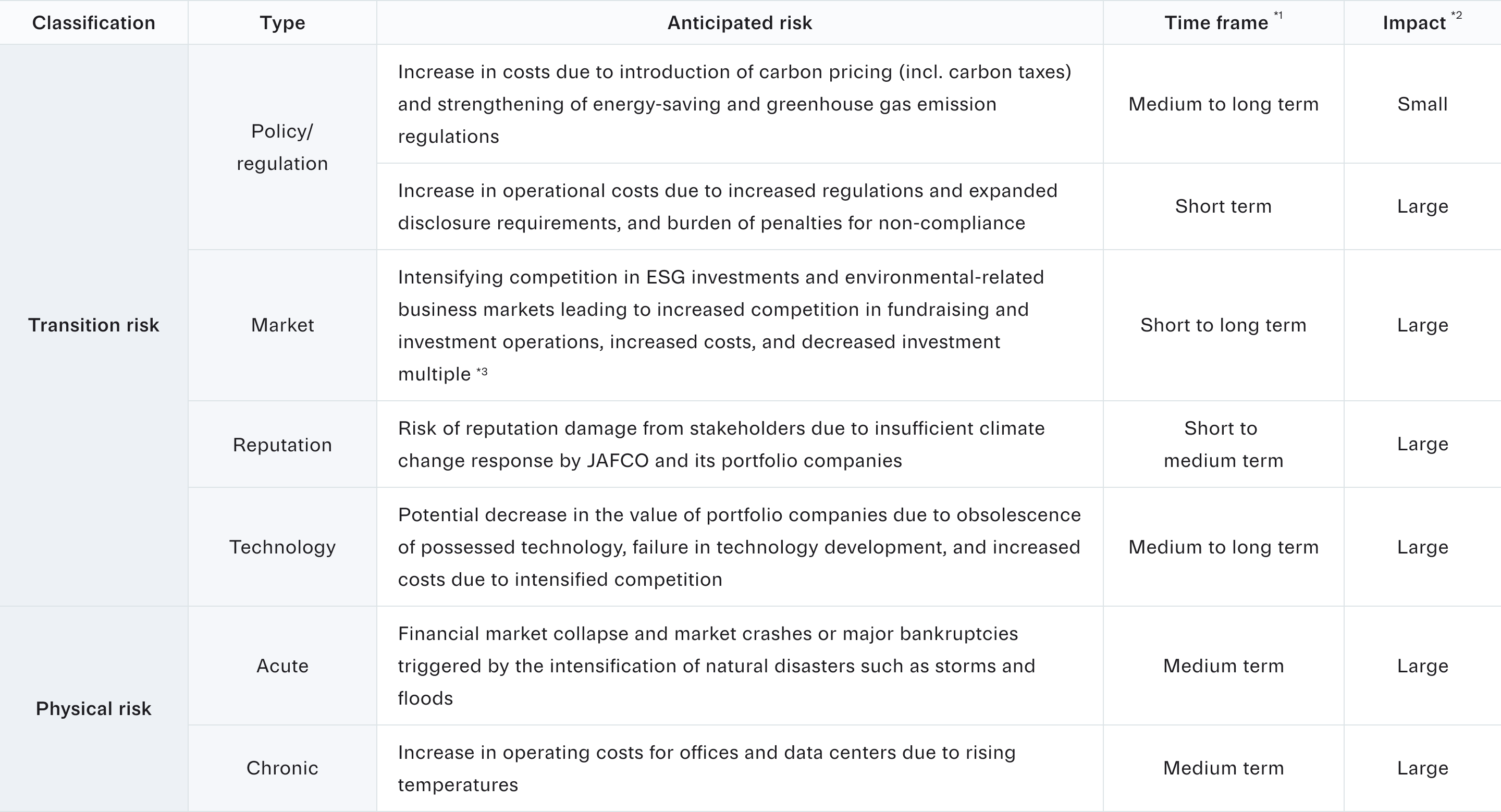
Initiatives for TCFD Recommendations
We recognize the environment issues as an important social challenge and are committed to reducing our environmental impact.
In May 2023, we endorsed the recommendations of the Task Force on Climate-related Financial Disclosures (TCFD).
Following the TCFD framework for information disclosure, we are identifying climate-related risks and opportunities using two scenarios in which the global average temperature increases by 4°C and by 1.5°C compared to pre-industrial levels.
Governance
Addressing sustainability concerns, including ESG issues, is one of our highest management priorities. The Administration Division oversees the progress of companywide sustainability initiatives and reports the status of these efforts at least once a year at a meeting of the Board of Directors, which supervises the initiatives by checking progress and discussing specific action policies and sustainability promotion measures.
Promotion Framework
Strategy
Following the Taskforce for Climate-related Financial Disclosures (TCFD) framework for information disclosure, we identified climate-related risks and opportunities using two scenarios in which the global average temperature increases by 4°C and by 1.5°C compared to pre-industrial levels. The most significant impacts on our business are summarized below. Moving forward, we will continue to explore measures to achieve a decarbonized society.
Risks


Opportunities


*1 The time frames (impact period) of the risks and opportunities are based on the following:
- Long term: Impact to occur within 10 to 30 years from now
- Medium term: Impact to occur within 4 to 9 years from now
- Short term: Impact to occur within 0 to 3 years from now
*2 The impact of the risks and opportunities on our business are based on the following:
- Large: The impact of the risk/opportunity is significant
- Small: The impact of the risk/opportunity is minor
*3 The following specific risks are currently anticipated:
- Increase of investigation costs during the phase from identifying investment candidates to making investment decisions and execution
- Intensification of investment competition due to the entry of ESG-specialized funds
- Increase of acquisition costs due to the rising valuation of companies providing ESG-related services
- Increased ESG support costs during the phase of enhancing corporate value of portfolio companies
- Risks such as prolonged periods to exit due to stricter ESG check standards
*4 The following specific opportunities are currently anticipated:
- Increased investment opportunities in companies engaged in environmental-related businesses such as the renewable energy sector
- Increased exit opportunities and valuation growth due to increased M&A demand for companies providing environmental-related businesses such as decarbonization
Risk Management
Although we are implementing sustainability measures, if these efforts prove insufficient and our ESG investment, measures for realizing sustainability and our overall response for ESG-related risks are perceived to be weak, we may not be able to maintain stakeholder support, resulting in our fundraising, investment activities, and ability to attract and retain human capital being adversely affected. This may negatively impact the performance and financial standing of the Company Group.
Also, we have endorsed the TCFD recommendations and will assess and manage risks and opportunities related to climate change, a critical global issue, and actively collect and analyze the necessary data to evaluate and manage these risks in alignment with TCFD recommendations while also ensuring appropriate information disclosure. However, if our disclosures are deemed insufficient, this could lead to a diminution of the Company Group's corporate value, which may negatively impact the performance and financial standing of the Company Group.
Indicators and Targets
Since the fiscal year ended March 2018, we have been calculating Scope 1 and Scope 2 GHG emissions. We are currently deliberating the setting of GHG emission reduction targets (Scope 1, 2) and the calculation of GHG emissions of our supply chains (Scope 3).
Change in Greenhouse Gas Emissions (Unit: t-CO2)
| 2016.3 | 2017.3 | 2018.3 | 2019.3 | 2020.3 | 2021.3 | 2022.3 | 2023.3 | 2024.3 | 2025.3 | |
|---|---|---|---|---|---|---|---|---|---|---|
Scope1 |
- | - | 0.9 | 0.9 | 0.6 | 0.3 | 0.4 | 1.1 | 1.2 | 1.3 |
Scope2 |
- | - | 14 | 8.8 | 8.5 | 7.2 | 7.7 | 7.9 | 2.6 | 2.5 |
Total |
- | - | 14.9 | 9.7 | 9.1 | 7.5 | 8.1 | 9 | 3.8 | 3.8 |
Scope of calculation:
Scope 1 (direct emissions from the use of fossil fuels, etc.) and Scope 2 (indirect emissions from purchased electricity and heat) emissions, which are defined by the Greenhouse Gas Protocol, of our domestic offices (excluding the former Chubu and Kyushu branches which merged with the West Japan Branch in September 2021) are indicated. The emission factors by electricity and gas providers used for the calculation of Scope 2 for the fiscal year ended March 2024 are based on the most recent data available as of the end of June 2024.

Environment

